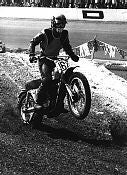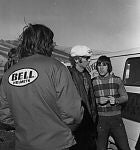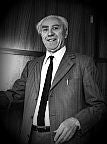It's a combination of the nasty characters of Dallas, the back-stabbing of day-time soap operas, the devious behavior of a Savings and Loan scam artist and the trust-worthiness of a Clinton State Trooper. The story behind the fall of Maico, once the most prestigious European motocrosser made, is a bizarre and tortuous tale. This writer was able to acquire documents, copies of invoices, internal memos, legal papers, documentation from key sources and statements from key personnel. Like most people, we thought that Maico simply fell on hard times, or fell apart at the seams from poor business practices. However, when we got the real facts and inside information, it became apparent that plain old greed and an internal family takeover brought the company to its knees. THE GLORY DAYS Dirt bikes started becoming enormously popular in the mid and late 60s in the United States. By 1970, the big hitters in the game were CZ, Husky and Maico. If you rode one of these, you were among the elite. You had "Yur-peen" iron. Your bike handled, had correct power and went where it was pointed with no ugly surprises. Your options were few: You rode an ill-handling, utterly reliable Japanese bike, or some half-finished British or Italian machine made up of ill-matched parts. Right around 1971, the Maico was so superior in handling and power, that it was almost like cheating. I can recall being a back-of-the-pack Novice with a Yamaha DT-1, then almost immediately after buying a 400 Maico, I actually started winning races!
The power of the big-bore Maicos was not only there in abundance, it was smooth from idle all the way to peak revs. A properly jetted 400 or 440 Maico would simply eat any other bike of that era alive in the race to the first turn. Certainly, they were fussy. Learning to live with the temperature-sensitive Bing carb required patience and a tool-box full of jets. The primary chain driven left side of the engine required constant attention, and key nuts and bolts had to be secured with industrial strength Loctite. The front brake was more decorative than effective. Rims, grips, air boots, cables and fiberglass fenders were all disposable items. All that aside, the Maicos would turn under anything else on the track, go straighter than a tossed spear and accelerate like the Hounds of Hell were after it. Forget the marginal brakes; the rider could simply concentrate on keeping the throttle pegged and passing everything else in sight, with absurd ease. Sales, during this era, were spectacular. Dealers reported groups of riding buddies coming into their shops and all of them buying new Maicos at the same time. One dealer noted that when the new '71 400s hit the market, he received 40 orders for bikes on a single Saturday. Ah, yes, those were glorious days. Simple days. Days when a brand new 400 Maico sold for about $1100. You could race it for a year, then sell it for maybe $800 or so.
A brute of a bike, it had a staggering spread of power and all the legendary Maico handling habits, in spite of wimpy shocks. People bought the bike in droves, and even willingly paid the extra money for decent after market shocks. The bike was so good, that every Japanese factory bought several 490's and tore them apart down to the last nut and bolt to study them. It took another three years before Japan figured out how to successfully copy the power-band of the 490 Maico ... and the copies were just that, pale copies.
With this kind of brilliance, one might think that success was assured at the Maico factory, but as we shall see, there were inner forces at work to undermine all the good times. In 1983, Maico came out with even more outrageous power. It was so good, so flexible, so usable, that to this very day, it's held up as a standard for modern MX bikes to shoot for. I distinctly recall the press day preview of the '83 490 and the introduction of the Sand Spider models. It was at Indian Dunes, and the gathered magazine types and selected dealers who got to ride the bike for a few laps came back slack-jawed and shaking. The bike was a pure brute, but a controllable one. After riding the bike, I was equally impressed, but concerned at the same time. The rear suspension was horribly off, so much so, that the bike sagged in the rear and the shock did little more than move up and down, seemingly at random. When I expressed my concerns to the Maico people, they shrugged and said this was simply a prototype, and that all the settings were off. The production bikes, we were assured, would be correct in all respects. THE NIGHTMARE OF 1982/83 People bought the new Maicos in droves, based mostly on enthusiastic magazine test reports. Few of the magazines knew that the distributors gave the press carefully prepped bikes, with most of the flaws removed. But when the average rider/racer out there bought the bike, the fan started getting pelted with dung. Shocks broke on almost every 1982 bike sold. In 1983, transmissions started shredding gears like popcorn, and even bizarre things like rear hubs exploded. Dealers started getting bombarded with complaints from irritated customers, and even lawsuits from injured customers. When a person buys a bike, he doesn't expect the rear end to collapse from a broken shock when landing from a normal jump. And he certainly wouldn't expect a rear hub to explode when braking at the end of a high-speed straight-a-way! In spite of heroic attempts by the U.S. Maico distributor to warranty all the claims, the harm was done. By 1984, Maico was in bankruptcy. From that point forward, no matter who tried to salvage the marque (M-Star being the first futile effort), it was all over. Maico, as we knew it, was dust. BACKGROUND YOU NEED TO KNOW Maico was founded in the early '30s by Otto Maisch and his brother, Wilhelm. They were equal partners in the company until the end of World War II. Things got strange after the war, as Wilhelm had been a Nazi, while Otto and his family stayed out of politics and concentrated on business.
Because Wilhelm had been a member of the National-Socialist Party, by law, he was only eligible to be a minority stockholder in the new company. This gave Otto 60 percent control and 40 percent went to Wilhelm's family. In 1957, Wilhelm was paralyzed, and became little more than a figure head in the company, leaving the day-to-day operations to Otto. Wilhelm's sons completed their education and were immediately given jobs in the Maico company. Hans became a motocross rider and helped with input on developing the machines. Peter was put in administration and, because of lacking any real skills, was also made a media/press relations person. Wilhelm Jr., who had some engineering skills, was put in charge of Technical Development and Production. Maico grew so rapidly that it was necessary to establish a distribution network in the United States. Maico Motorcycles Inc., was established on the East Coast and Cooper Motors handled the booming West Coast trade. In their hey-day, Maico sold more Open Class bikes than Honda does today in total motocross bike sales. By 1976, Frank Cooper (West Coast distributor) retired and Maico took over distribution and sales in the U.S. with a company of their own. At this period in dirt bike history, Maico sold anywhere from 30 to 50 percent of their total production in the U.S. Their image at the time compared favorably with Mercedes and Porsche. Right around 1980, Maico started feeling pressure from the relentless Japanese manufacturers, and was forced to respond with some new "breakthrough" machinery. The new 1981 250 and 490 engines were the result of that pressure. In 1981, Maico was the world leader in 500cc motocross bike sales. In comparison, giants like Suzuki, were selling a mere 1500 open class bikes per year in the U.S.. But the suspension revolution was now in full swing, and Maico realized that they had to come up with a modern single-shock design. To accomplish this, Maico was forced to borrow money to design a completely new system. They ran into a brick wall when the Credit Bank of Baden Wurttemberg turned down their loan application because the Wilhelm Maisch family refused to co-sign and put up their share of collateral for the loan. The Otto Maisch side of the family was forced to sink almost every remaining Mark they had to save the company. THE BEGINNING OF THE END Here's where the plot thickens. And this is the point in time where the Wilhelm Maisch family started to tighten the screws on Otto and his clan. The 1982 Maico was a disaster, both in concept and acceptance by the off-road public. It was their first single shock concept, and rather than use a tried-and-true approach, the Wilhelm Maisch family screamed long, loud and hard to keep costs down. Therefore, the bikes came equipped with Italian Corte & Cosso shocks. While Corte & Cosso had a great reputation for building shocks for Ferraris, their experience in dirt bikes was pathetic. The shocks were the wrong length, and not designed for the correct stroke. Worse, the top and bottom frame shock mounts didn't line up at all, and when the shock was stroked fully, it would cock to one side and either bend, or worse yet, break. The rear suspension was so poorly designed, that the shocks had to be hammered into their mounts with large brass hammers at the factory. When the U.S. distributors started to receive complaints from unhappy owners, they were forced to remove the damaged shocks with large pry bars. Further investigation of new bikes still in the crates, showed that virtually every bike was delivered with the faulty shock and mounting design. Otto Maisch directed that new Ohlins shocks be supplied free of charge under warranty, with proper spacers to allow the shock to work. These Ohlins cost twice as much as the Corte & Cosso units, but it was the only way to salvage a ruinous situation At the time, no one understood how such a bizarre thing could have happened. Since Wilhelm was in charge of development, he tried to blame it on Corte & Cosso, but the Ohlins engineers noted that no shock would have survived with the system designed like it was! Knowing full well that they couldn't face another year without meeting the Japanese bikes on at least an equal basis, Otto Maisch put the pressure on the factory - and Wilhelm Maisch, Jr. - to make the 1983 Maico a landmark model. It had to be good. Better than good. It had to be great! I had a chance to ride a pre-production bike four months before the press saw the machines. They air-freighted a new generation motor over and we stuffed it in an existing bike, and went testing. Good God almighty! What an engine!!! The thing pulled like a freight train on nitrous oxide. I fell in love with the engine and even went so far as to help the company come up with a trick name for the new bike: The Spider. And for the five speed desert version, I came up with the Sand Spider. If Maico thought the 1982 model was a problem, the 1983 bikes made all that seem pale by comparison. While the initial reception at the press day was awesome, when the production bikes hit the real world, it was pure grief. The dealers got hammered against the wall. Complaints poured in. Riders bitched loudly, as well they should. Money poured out of the factory, while very little was coming in. Sales dropped. The reputation of Maico plummeted. The old Maico-Breako slogan was revived in full force. And even though the factory had covered all the dead shocks in 1982, eating wads of money in the process, new grief cropped up with the Spider models. Gear boxes started self-destructing at an alarming rate, and as said earlier, hubs blew up like cheap balloons. Confidence in the Maico disintegrated. Sales virtually stopped. Dealers were forced to sell bikes at no profit, or at a loss, just to clear the floors. By the end of 1983, Maico had a stake driven into its heart. Strangely, during this same sad year, there were Maico owners who never had a bit of trouble. The gearboxes worked just fine. No hubs broke. And the revised Ohlins shocks went up and down quite nicely, thank you. PART II of "WHAT KILLED MAICO?" continued next month!
|
Follow @Off-Road







 Your Privacy Choices
Your Privacy Choices